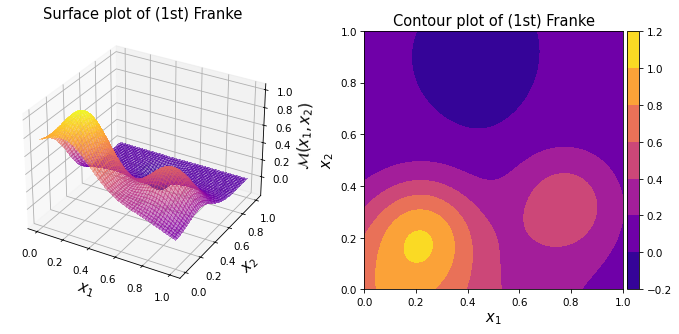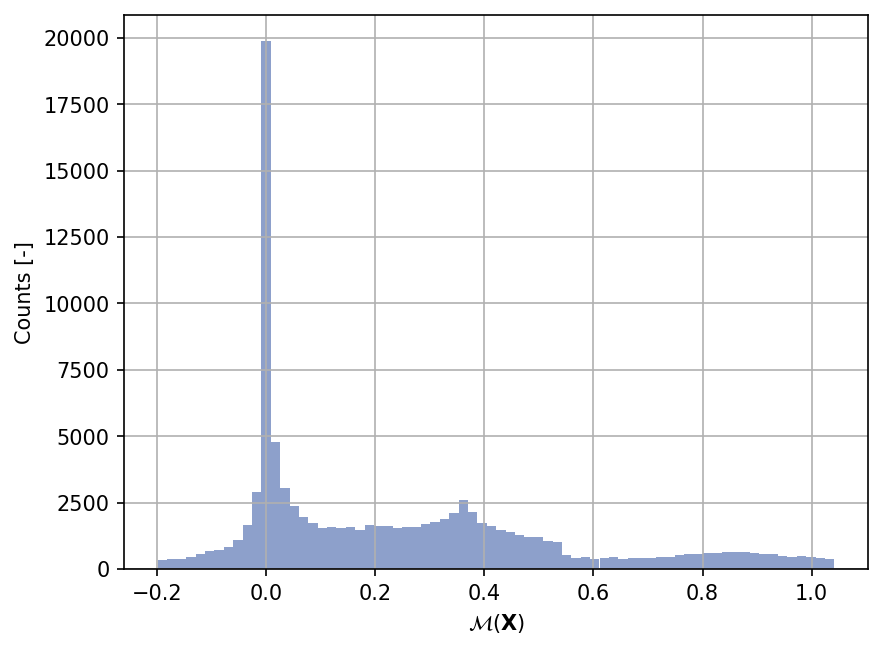(1st) Franke Function
Contents
(1st) Franke Function#
import numpy as np
import matplotlib.pyplot as plt
import uqtestfuns as uqtf
The (1st) Franke function is a two-dimensional scalar-valued function. The function was first introduced in [Fra79] in the context of interpolation problem and was used in [HQ11] in the context of metamodeling.
Note
The Franke’s original report [Fra79] contains in total six two-dimensional test functions:
(1st) Franke function: Two Gaussian peaks and a Gaussian dip on a surface slopping down the upper right boundary (this function)
(2nd) Franke function: Two nearly flat regions joined by a sharp rise running diagonally
(3rd) Franke function: A saddle shaped surface
(4th) Franke function: A Gaussian hill that slopes off in a gentle fashion
(5th) Franke function: A steep Gaussian hill that approaches zero at the boundaries
(6th) Franke function: A part of a sphere
The term “Franke function” typically only refers to the (1st) Franke function.

As shown in the plots above, the surface consists of two Gaussian peaks and a Gaussian dip on a surface sloping down toward the upper right boundary (i.e., at \((1.0, 1.0)\)).
Test function instance#
To create a default instance of the Franke function:
my_testfun = uqtf.Franke1()
Check if it has been correctly instantiated:
print(my_testfun)
Name : Franke1
Spatial dimension : 2
Description : (1st) Franke function from Franke (1979)
Description#
The Franke function is defined as follows:
where \(\boldsymbol{x} = \{ x_1, x_2 \}\) is the two-dimensional vector of input variables further defined below.
Probabilistic input#
Based on [Fra79], the probabilistic input model for the function consists of two independent random variables as shown below.
my_testfun.prob_input
Name: Franke1979
Spatial Dimension: 2
Description: Input specification for the test functions from Franke (1979).
Marginals:
| No. | Name | Distribution | Parameters | Description |
|---|---|---|---|---|
| 1 | X1 | uniform | [0. 1.] | None |
| 2 | X2 | uniform | [0. 1.] | None |
Copulas: None
Reference results#
This section provides several reference results of typical UQ analyses involving the test function.
Sample histogram#
Shown below is the histogram of the output based on \(100'000\) random points:
xx_test = my_testfun.prob_input.get_sample(100000)
yy_test = my_testfun(xx_test)
plt.hist(yy_test, bins="auto", color="#8da0cb");
plt.grid();
plt.ylabel("Counts [-]");
plt.xlabel("$\mathcal{M}(\mathbf{X})$");
plt.gcf().set_dpi(150);

References#
- Fra79(1,2,3)
Richard Franke. A critical comparison of some methods for interpolation of scattered data. techreport NPS53-79-003, Naval Postgraduate School, Monterey, Canada, 1979. URL: https://core.ac.uk/reader/36727660.
- HQ11
Ben Haaland and Peter Z. G. Qian. Accurate emulators for large-scale computer experiments. The Annals of Statistics, 39(6):2974–3002, 2011. doi:10.1214/11-aos929.

